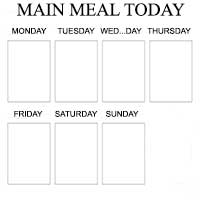Meals by day of the week, early 20th century, England

The main meal, which was at mid-day in the early 1900s, was different each day of the week, but was the same with minor variations for that weekday irrespective of the season. So if you knew the day of the week, you knew what your meals would be. This page explains why and describes the meals for each day of the week.
____
Extracted from the memoirs of the webmaster's mother (1906-2002) and edited by the webmaster with further research and firsthand contributions from others
The menu for all our meals when I was a child in the early 1900s was dictated by two constraints: There being no fridges to keep food fresh and cooking had to fit in with the woman's other work. Yes, it was always the woman's work, even though she relied heavily on the help of her children. If you bear both of these constraints in mind, you will understand why our menus for the week were more or less fixed, although of course there were always the slight variations and treats.
Sunday: the roast
On Sunday there was always a roast meal - and I mean always - because it provided the framework for the menu for the rest of the week. It was generally roast beef which has its own page and in-season vegetables. It was served with masses of in-season vegetables, with fruit pie afterwards.
It was fairly usual on a Sunday evening to have cold sliced meat from the roast and its left-over vegetables for supper, followed by cold fruit pie.
Monday: cold meat and bubble and squeak
Monday was washday so my mother had no time to do any significant cooking. For dinner [lunch] when we came home from school, we always had sliced cold meat from the previous day's Sunday roast, served with bubble and squeak which was fried mashed-up cold vegetables, again from Sunday's roast. We ate these with mustard pickle that one of us children had to go and buy from the shop at the shop at the end of the road. We had to take our own basin. It was sold from large jars and cost 1 or 2 coppers.
Tuesday: more cold meat and bubble and squeak
Tuesday was ironing day which was was still busy for my mother as there were no non-crease fabrics. So our dinner [lunch] was the same as Monday's. This usually saw the last of the meat that could be sliced and eaten cold.
Wednesday: stew and dumplings
The remainder of the Sunday roast was made into a stew for Wednesday. For me, the best part of this meal was the suet dumplings that my mother made to go with with it.
Thursday, Friday and Saturday: variety
Although the Sunday roast was completely finished by Thursday, we still had a good dinner during the rest of the week. What we had varied. Sometimes, for example, it was meat rissoles; sometimes it was meat pudding. I often had to go out before school to buy the meat for the dinner and it was always ¾ lb of leg of beef and a ½lb of beef suet. I used to really enjoy these meals. Other everyday meals that I particularly remember are on their own separate page.
Meals which were the same every day: breakfast, tea and supper
Breakfast, tea [the evening meal] and supper [bedtime snack] were the same every day.
Breakfast
My father went to work very early and came home for breakfast which was usually bacon for him and porridge for us children. It was completely usual for children to have poorer quality food than the men of the family. The porridge was not at all refined but coarse with a good many husks which I used to line up round the edge of my plate. It was made with water and sweetened with brown sugar. We did have milk on it but not very much and it was always cold, poured on once the porridge was on the plate. It made me think of a moat from my history book.
Tea - the evening meal
When we children came home from school at the end of the afternoon, tea was simple: bread and jam or bread and dripping (from the Sunday roast) and a slice of cake if any was left from the Sunday baking.
Bedtime snack
There was cocoa and bread and cheese or dripping at bedtime.
If you can add anything to this page or provide a photo, I would be pleased if you would contact me.
Text and images are copyright
sources: early 20th century material
sources: ww2 home front and other material
contact
the webmaster/author/researcher/editor
privacy policy



